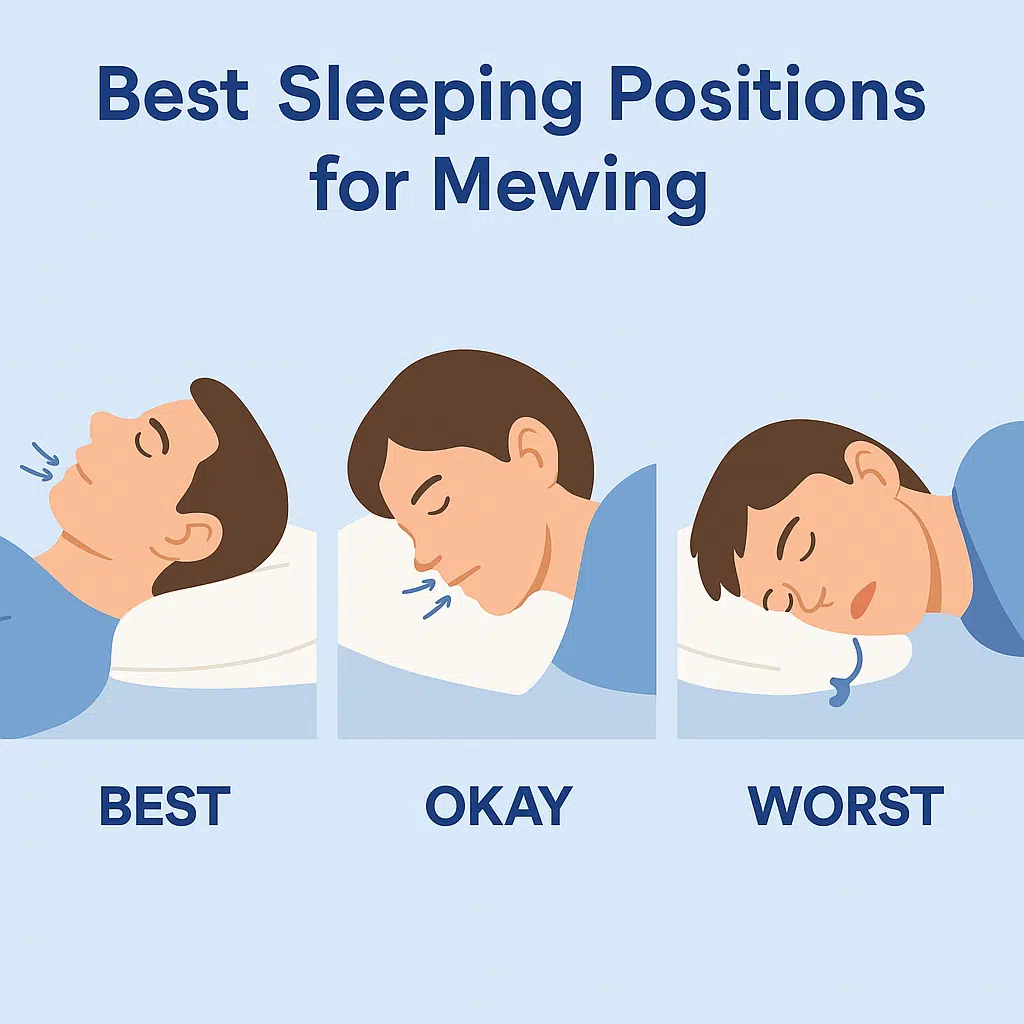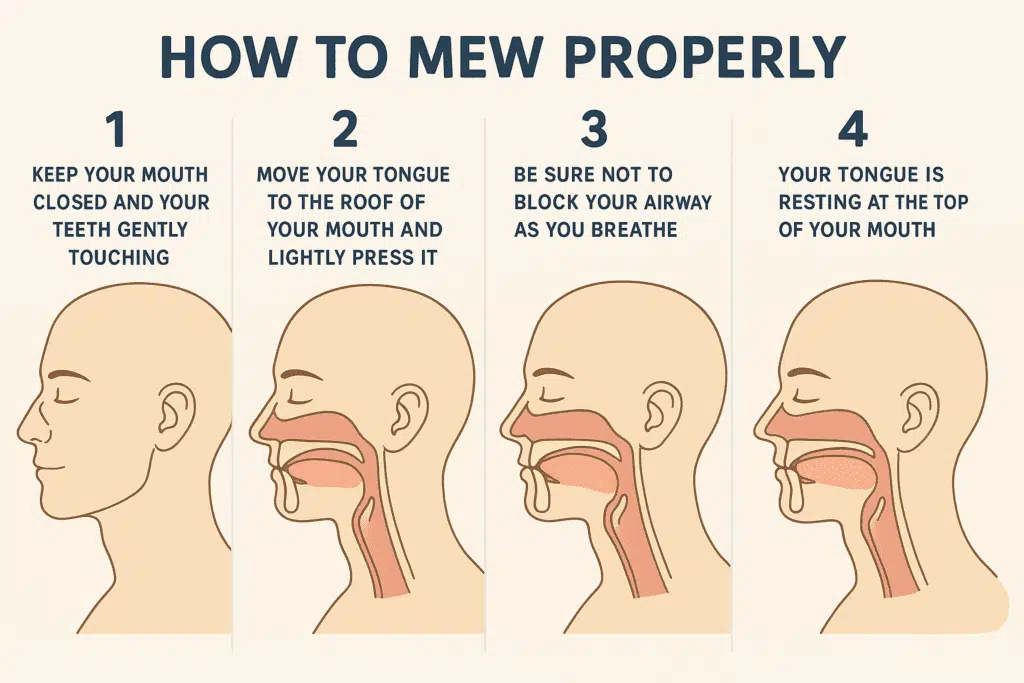How to Mew While Sleeping: 4 Easy Ways
Mewing requires you to position your tongue completely while resting against your mouth roof keeping your lips sealed during nose breathing. The prolonged application of this method appears to produce benefits for facial growth alongside improved jaw shape, and it also helps people breathe better.
In this guide, I will provide a step-by-step approach to mastering this skill. It is full of actionable tips, practical advice, and everything you need to know to succeed.

What Is Mewing?
Mewing serves as a method that requires proper tongue placement to develop improvements in facial form, together with jaw definition and breathing system, while benefiting oral health over an extended time.
The core principles of mewing involve:
- Pressing your entire tongue (not just the tip) against the roof of your mouth
- Keeping your lips sealed
- Breathing through your nose
Done consistently over time, mewing is believed to:
- Improve facial structure
- Define the jawline
- Correct oral posture
- Support better breathing patterns
Why Is Nighttime Mewing So Important?
Your sleep duration extends from 6 to 9 hours throughout each night. The time you spend awake is just a fraction of your total opportunity to enhance tongue position because nighttime mewing provides greater reinforcement of proper tongue posture.
Consistent tongue posture during sleep helps:
- Prevent mouth breathing
- The symptoms of snoring and sleep apnea lose their intensity during nighttime use.
- Maintain better facial alignment
- Improve the results of daytime mewing

Can You Mew While Sleeping?
Yes, but with effort and conditioning.
The process comes down to:
- Your daytime brain and muscle training allows progress in mewing techniques throughout the day.
- Designing an environment for rest that promotes breathing through the nose.
- If physical supports are needed they can assist in maintaining the habit.

Step 1: Master Daytime Mewing First
For proper sleep-time mewing, you need to establish correct nighttime and daytime mewing. The practice established during daytime mewing creates stability for effective nighttime mewing.
What Proper Daytime Mewing Looks Like
Make sure to check these key points consistently throughout the day:
- ✅ Lips lightly sealed (no tension)
- ✅ Teeth slightly touching (not clenched)
- ✅ The entire tongue (tip to back) pressed against the roof of the mouth
- ✅ You only breathe through your nose
Tongue exhaustion is no reason for concern at this early stage of practice. Such initial normalcy in tongue movement is perfectly acceptable. Your tongue requires muscle strength training to securely maintain appropriate positions like other body muscles.
Pro Tip to Make It Subconscious
- Schedule alerts for each passing hour through your phone interface.
- After the alarm goes off you should verify your posture alongside your tongue positioning.
- The habit will gradually transform into an automatic behavior.
At this moment, when you maintain the posture automatically during daytime hours, you can begin practicing mewing during sleep time.
Step 2: Improve Your Sleeping Position
Sleep during nighttime either strengthens or weakens everything you have accomplished through mewing during daytime.

Best Position: Back Sleeping (Supine)
Nighttime mewing is best performed from this particular sleeping position.
- Allows the tongue to fall naturally back onto the palate.
- Helps maintain nasal breathing.
- The method helps to prevent jaw muscles from accidentally opening forward.
You should use a neck support pillow that avoids tube-like pressure on your head. A proper sleeping posture helps maintain an open air passage while keeping your tongue in an elevated position.
Worst Position: Stomach Sleeping
Avoid this at all costs.
- Forces your mouth open.
- Misaligns your neck and jaw.
- Encourages mouth breathing.
Side Sleeping: Acceptable but Risky
- Can lead to the mouth falling open.
- You can reduce side sleep-induced mouth opening by using chin straps or mouth tape as per our later discussion.
👉 Use a chin strap or mouth tape (more on that later) to help keep your mouth closed if you sleep on your side.
Read more: https://eyesonhunt.com/how-to-tell-if-you-have-a-good-maxilla/
Step 3: Train the Tongue with Oral Exercises
Detailed training of the core muscles parallels the practice required for tongue muscle development to maintain proper positions without conscious effort.
Effective Oral Exercises
Here are exercises you can practice daily:
Tongue Pushes
- Press your whole tongue against your palate.
- Hold for 5–10 seconds.
- Repeat 10 times, 2–3 times a day.
“N” Sound Hold
- Say “n” and freeze your tongue in that position.
- That’s near the correct mewing posture.
- Hold it for as long as is comfortable.
Suction Hold
- Press your tongue against the roof of your mouth.
- Try to create suction so the tongue sticks.
- Hold for 30 seconds.
- Repeat throughout the day.
The tongue strengthening exercises help your body develop the necessary strength and memory for keeping your tongue positioned correctly while sleeping.
Step 4: Try Mouth Taping (Optional but Effective)
It is a basic yet secure method to use mouth tape as a tool that improves nasal breathing while preventing the lips from opening.
Why Mouth Taping Works
- This device stops your mouth from opening during sleeping hours.
- Encourages you to breathe through your nose.
- The specific placement of the tongue throughout the night remains supported by this method.
What Kind of Tape to Use
- ✅ Somnifix stands apart as the specific device for mouth taping applications.
- ✅ The vertical cut of hypoallergenic medical tape functions as a taping tool.
Important Safety Check
- You must be able to breathe through your nose comfortably before trying this.
- Medical care for nasal congestion and allergies or deviated septum becomes essential before using this treatment.
If you can’t breathe freely through your nose, mouth taping will do more harm than good. Always prioritize safety.
Step 5: Clear Your Nasal Airways
Nasal congestion prevents both nasal breathing and correct mouth breathing, so you need to open your nasal passages first. Because nasal airway clearance stands as your main objective.
How to Keep Nasal Passages Open
- Saline spray rinses with a neti pot should be used as a nighttime routine for open nasal airways.
- You should apply Breathe Right nasal strips as a physical method for opening your nostrils.
- People need to drink fluids continuously throughout regular hours.
- You should remove dust, along with pet dander and mold, from your bedroom environment.
- Use an air purifier if needed.
If Nasal Congestion Persists
Head to an ENT specialist for consultation. The medical treatment of chronic sinusitis along with nasal polyps and structural problems is typically necessary.
Step 6: Use a Tongue Posture Trainer (Optional Tool)
A tongue posture trainer together with a myofunctional appliance serves as an optional tool to help maintain tongue positioning even if you struggle to do so after practicing.
Devices That Can Help
- Myobrace: Myobrace is a removable device that guides the forehead muscles and tongue to correct their positions.
- Vivos Appliance: The Vivos Appliance functions to treat sleep apnea together with tongue positioning benefits.
- Custom Dental Devices: Designed by airway-focused dentists to support proper posture.
Read more: https://eyesonhunt.com/high-cheekbones-vs-low-cheekbones/
Important Note
- Always consult a trained professional before using one.
- Verifiable success from these tools depends on their integration with correct exercises together with patient education.
The appliances function as supplementary tools to support your mewing progress during your sleep hours.
How Long Does It Take to See Results from Mewing?
The process of mewing takes an extended time and requires maintenance for the long term.
During mewing practice, you may start observing minor modifications in:
- 3–6 months (if consistent with day and night practice)
- A complete restructuring of your bite will require 12 to 24 months.
People between the ages of 25 and below have bones that transform better to Mewing, but older individuals can improve their breathing through better posture.
Signs That You’re Successfully Mewing at Night
The following signs help determine that your tongue maintains a proper resting position during sleep:
✅ When you rise from sleep, your lips remain closed after release.
✅ The touch of your tongue against the roof of your mouth becomes noticeable to you each time you awaken.
✅ Your oral cavity remains wet and you avoid dryness in the mouth.
✅ Your snoring decreases along with disturbances during your sleep.
✅ Improved nasal breathing during the day
If you wake up with a dry mouth or sore throat, that may be a sign that your mouth opened during sleep and your tongue dropped.
Final Thoughts: Can You Mew While Sleeping?
Your body becomes capable of mewing throughout sleep cycles given proper dedication and strategic training methods. This training procedure acts similarly to proper mouth posture. The training techniques used for better posture apply equally to tongue position because it is possible to teach your tongue how to maintain its correct spot throughout the night.
It all comes down to:
- Consistency during the day
- Sleep environment setup
- Muscle strength
- Habit formation
By persisting with your efforts, you should achieve normal tongue placement, which becomes automatic even during nighttime rest.







